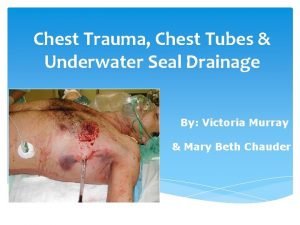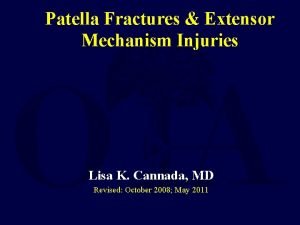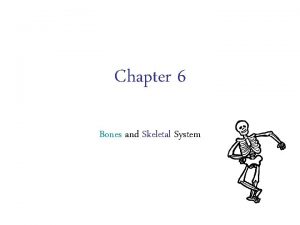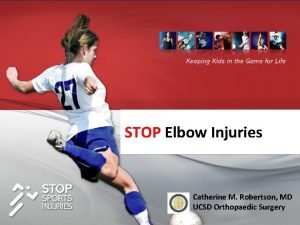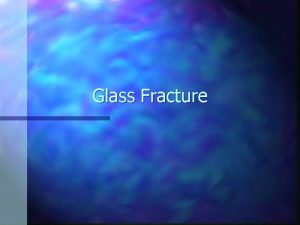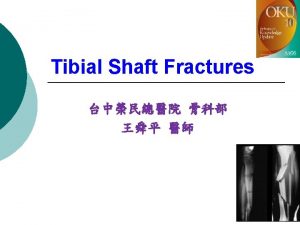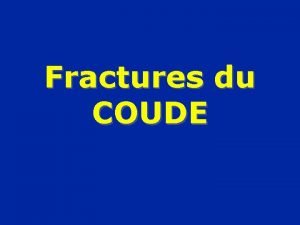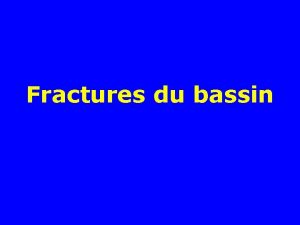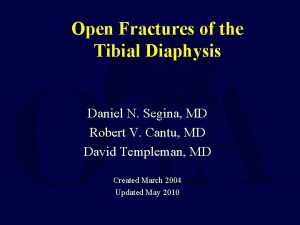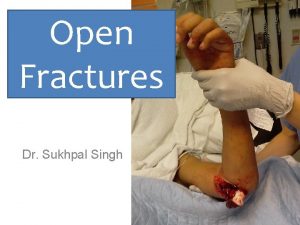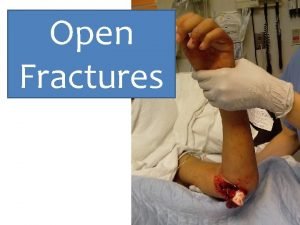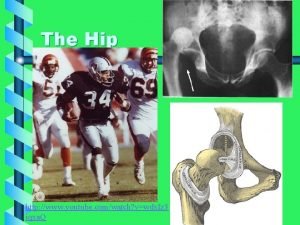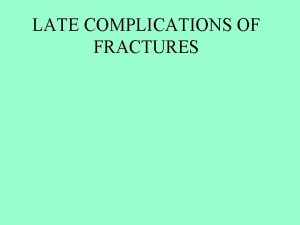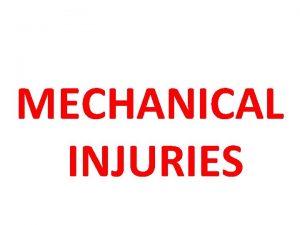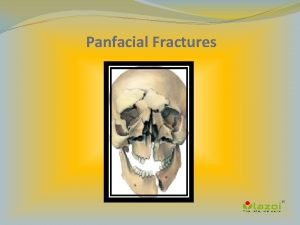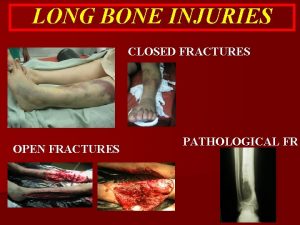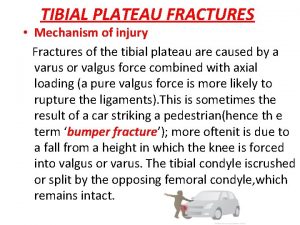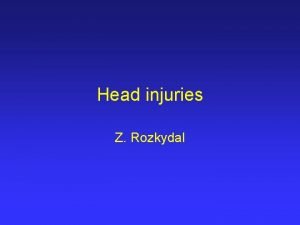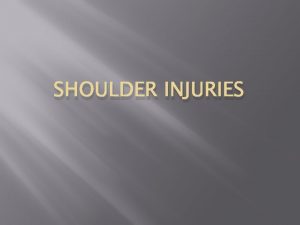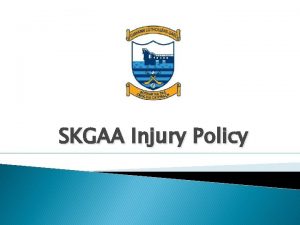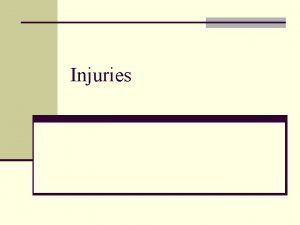Sport Injuries Types of Injury Fractures Occur as



















- Slides: 19

Sport Injuries Types of Injury Fractures – Occur as a result of extreme stress placed on bones. - Different types of fractures can occur based on the kind of stress (ie. Compression, bending, twisting, shear…) Management: RICE and immobilization. Healing most often requires immobilization in a cast, or soft splint. However, smaller bones cannot be cast and may require splint.


Sport Injuries Stress Fracture - Result from overuse rather than trauma. - Repetitive forces transmitted through the bones produce irritations at specific spots on the bone (marathon runners). - Pain starts as a dull ache but progresses each day. - Management: RICE. Recommended to stop activity for at least 14 days. Can become fractures in time.


Sport Injuries Dislocations - Occurs when one bone in a joint is forced out of its normal alignment (ie. shoulder). - Often results in rupture of surrounding tissue. - Joint is vulnerable to more dislocation. - Dislocations should never be immediately reduced, need to rule out fracture possibility - Management: RICE. Reduced by physician only! Before taken to physician, injury should be splinted.


Sport Injuries Sprains - Injury to a ligament. Ligaments connect bone to bone. Grade 1 Sprain - Some stretching of ligaments occurs - Expect mild to moderate pain, localized swelling, joint stiffness

Sport Injuries Grade 2 Sprain - Some tearing and separation of the ligament - Moderate joint instability - Moderate to severe pain, general swelling Grade 3 Sprain - Total tearing of ligament, major joint instability - Usually need exceptional load - Severe pain may be followed by no pain - Swelling may be great, joint becomes very stiff, may require surgery

- Initial management of sprains: RICE -Weight-bearing activity as soon as can be endured -Heat can be applied after initial 48 hrs. of RICE to relax tight ligaments

Sport Injuries Contusions - An external blow causes soft tissue to be compressed against hard bone underneath - Capillaries are torn, which allows bleeding into tissues causing blue-purple discoloration - Calcium deposits may result with repeated trauma Management: RICE and protect this injury


Sports Injuries Concussion (Brain Contusion) - An external blow to the head which causes an injury to the brain - A mild concussion may involve no loss of consciousness (being "dazed") or a very brief loss of consciousness (being "knocked out"). - A severe concussion may involve prolonged loss of consciousness with a delayed return to normal.

Sports Injuries Management: - Apply ice to area of impact and limit athlete movement - Have athlete seek medical treatment - No activity until asymptomatic - Return to activity follows concussion protocol. Risks: - Post-concussion Syndrome: experience of headache, nausea, or difficulty concentrating for weeks after injury - Second Impact Syndrome: repeated concussions (especially in quick succession) can result in fatal brain swelling

Sport Injuries Strains - Tearing of the muscle fiber - Occur when a muscle is overstretched or forced to contract against too much resistance Grade 1 Strain - Some muscle fibers stretched or torn - Movement is painful but full range is possible

Sport Injuries Grade 2 Strain - A number of muscle fibers have been torn - Movement is extremely painful - Swelling and discoloration may occur Grade 3 Strain - Complete rupture of the muscle - May be total loss of movement - Pain is intense then subsides due to nerve damage

-Hamstring is most common strain (rapid contraction in stretched position). Often due to muscle imbalance. Management: RICE. Heat and ultrasound may be used for long term rehabilitation. Rehab is longer than sprain because complete muscle rest is required.

Sport Injuries Muscle Spasms (Cramps) - Involuntary contraction of the muscle (ie. Gastrocnemius) - Pain and tightness associated - May be result of dehydration, loss of electrolytes, or muscle fatigue - Can last seconds or a number of minutes. - Muscle should be manually stretched and massaged to help relax the muscle. Hold the muscle in stretched position until the spasm eventually stops. - Chronic spasms (ie. Lower back) should be treated with RICE and a good stretching program. Heat / muscle relaxants provides temporary relief.

Sport Injuries Muscle Soreness - Overexertion in strenuous muscular exercise results in muscular pain - Delayed-onset muscle soreness (DOMS) occurs 12 -48 hrs. after exercise - Muscular pain, stiffness, and resistance to stretching is present - Preventable by gradually increasing exercise from moderate to intense over time

Sport Injuries Management: RICE and PNF stretching
 How to protect yourself from intentional injuries
How to protect yourself from intentional injuries Concentric fracture glass definition
Concentric fracture glass definition Chest tube bubbling in suction control chamber
Chest tube bubbling in suction control chamber Lisa kasman
Lisa kasman Canthatomy
Canthatomy Tubular shaft of a long bone
Tubular shaft of a long bone Types of glass fractures
Types of glass fractures Irving olecranon fractures
Irving olecranon fractures Concentric glass fracture
Concentric glass fracture Ao classification of fractures
Ao classification of fractures Supracondylienne
Supracondylienne Fracture de voillemier
Fracture de voillemier Primary bone vs secondary bone
Primary bone vs secondary bone Panfacial fractures sequencing
Panfacial fractures sequencing Daniel tibia
Daniel tibia Dr sukhpal singh
Dr sukhpal singh Open fracture treatment
Open fracture treatment Youtube
Youtube Acetabular ossification
Acetabular ossification Perkins timetable fracture healing
Perkins timetable fracture healing


